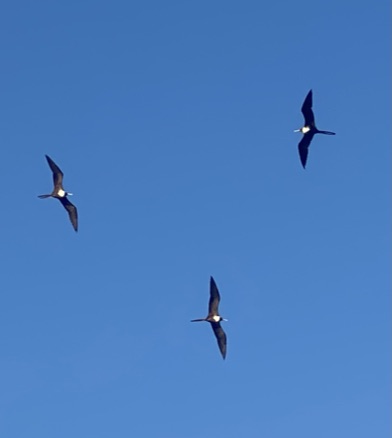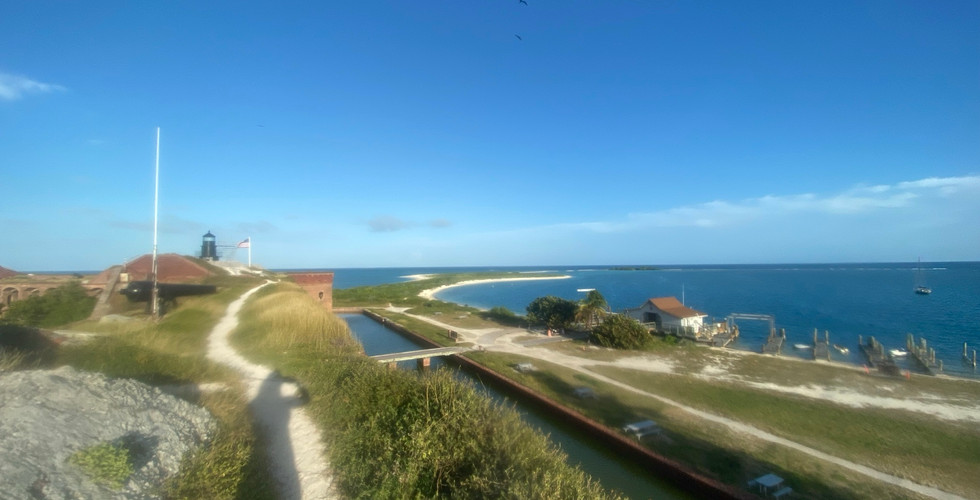Off the Grid
- Diana Aslin
- Jan 3, 2022
- 5 min read
No cell phone service. No internet. No fresh water. No provisions. We are in the Dry Tortugas, a national park, on an island about 70 miles west of Key West. The first thing we did was take a three hour nap then woke up and took some cockpit showers. We felt human again. Some of our friends, Todd and Susan, from Waterford Harbor, in Kemah, had sailed there on their Pacific Seacraft, Freya, and graciously offered to pick us up in their dinghy and cook us dinner that evening, which we were so grateful for.

The next day, on December 18th, we woke up with the sun, fresh and ready to explore. Most of our day was spent walking through the ruins of Fort Jefferson with our friends, Susan and Todd. Fort Jefferson was constructed to protect a deepwater anchorage along one of the busiest shipping channels. It took thirty years to build this fort but not to completion; it was never finished and never fully armed. The fort was used as during the Civil War as a prison for Union deserters to include its “most famous” prisoner, Dr. Mudd, the doctor that set the broken leg of John Wilkes Booth, the man responsible for the assassination of Abraham Lincoln.
There was also a preserved Cuban refugee boat that brought 33 Cubans to the Dry Tortugas. The U.S. has an immigration policy for Cubans known as “Wet Foot, Dry Foot,” that means that any Cuban that is able to physically set foot on U.S. soil are permitted to remain in the country legally and are put on an expedited track to gain citizenship. This is an approximately 110-mile journey from Cuba to the Dry Tortugas. The boat we saw did not have a galley or a head, it was just a boat that fit as many people as it could; people who were desperate for something different. Many of us may never know a desperation so great and therefore will never know the depth of courage and perseverance that a journey like that demands.
The views from the top of the three story fort were magnificent. At one point we saw what looked to be a three-to-four-foot sea turtle swimming. That evening we walked down the white sandy beach of Garden Key admiring the dozens of hermit crabs, hundreds of shells, and everything in between. It’s just crazy to think that as hermit crabs grow, they go in search of new shell. They had plenty to choose from on this stretch of beach but I imagine when it’s slim pickins it can be competitive.
We spent the next two days snorkeling with Todd and Susan, exploring life under the water. The first day we snorkeled around the entire fort and saw, barracudas, parrotfish, sergeant majors, and spiny lobsters. We were hoping to cross paths with that turtle but no dice. At one point, as we were rounding the final stretch of the island, I found myself alone with a barracuda that was about 4 feet long. No one was in sight and my first thought was, “Barracudas are attracted to shiny things…hide your ring.” I snorkeled the rest of the way with my left thumb over my left ring finger to hide my wedding ring. And yes, I am fully aware of my ridiculousness.
The next day we all piled into Waldo, the dinghy, and trekked out to Loggerhead Key to snorkel in Little Africa Patch Reef. Upon arrival, while beaching our dinghy, we were greeted by a man named Ray. He looked like Santa Claus on vacation. Ray and his wife live on Loggerhead six weeks a year, while they volunteer there. She does administrative work and he fixes things. Ray kindly offered to give us a tour of Loggerhead Key after our snorkel.
Little Africa was filled with coral, sea fans, some fish we recognized and others we didn’t. Of course, we forgot our GoPro, but it didn’t make the experience any less special; it was breathtaking. The coral and sea life was vibrant and seemingly thriving. We learned that is not the case for many reefs in Florida and the Bahamas, which makes Little Africa Patch Reef all the more special. We swam back to shore and Ray was there to give us an unofficial tour of Loggerhead Key, then we made the trip back to Garden Key.
We cleaned ourselves up and headed to shore later that afternoon and brought our snorkel gear in case we felt like snorkeling a little more. We were standing on the pier and low and behold, we spotted a Goliath Grouper. Blake has been talking about wanting to swim with this fish since from when we left St. Petersburg. In case you’re like me and unfamiliar with this fish, the Goliath Grouper can be up to eight feet in length and weigh up to 800 pounds. The one swimming was about six feet long. Needless to say, Blake threw on his snorkel gear and dove in and swam with this grouper side by side for about 10 minutes.

I saw Blake dive in deeper then all of the sudden I see him swimming very quickly to the dinghy. Here is his account of what happen:
When I followed him deeper, out of the depths of what was about 30 feet of water, a shark was swimming directly towards me at an extremely fast pace. I turned around and started kicking. I had my snorkel fins on and felt one make contact with the shark. I don’t know if it bumped his nose but he swam off and I made it into the dinghy from the water, which I didn’t know I could do.
It turns out, it was a six-foot lemon shark, and according the Park Ranger, Blake was swimming at a time and place when it’s dinner for sharks in the area. That could have really discouraged someone from getting back into the water, but not Blake, he was back in the water the next day. I found that inspiring because I know he was scared.

Only fear driven adrenaline could have resulted in the kind of agility he had going from the water into the dinghy like he did.
The anchorage had been peaceful until the evening before we left. A chartered (the person operating the boat did not own the boat – basically the boat is rented) catamaran enters the anchorage and is looking for a place to drop the hook. In this search he hooked his anchor to Freya’s anchor chain, and this catamaran captain only knew one speed and two directions, hammer down forward or hammer down reverse. At one point it looked as though he was dragging Freya and came close to hitting Freya several times, which made our stomachs turn repeatedly. This went on for about an hour until somehow he became unhooked then he came over and tried doing the same thing next to our boat. Blake was able to get him on the VHF and another sailor calmly walked him through how to drop anchor. Needless to say, we didn’t have dinner that night. What a fiasco!

























































































































































Great story, Diana, and awesome pics! Thanks for sharing. I would love to have see Blake & The Shark in action. I am sure he was squealing through his snorkel. 😂